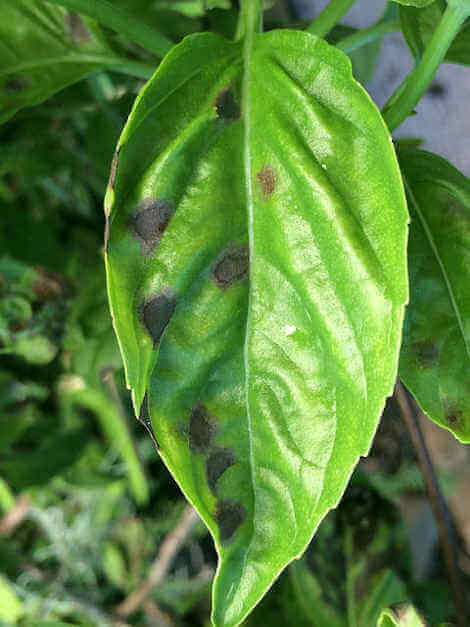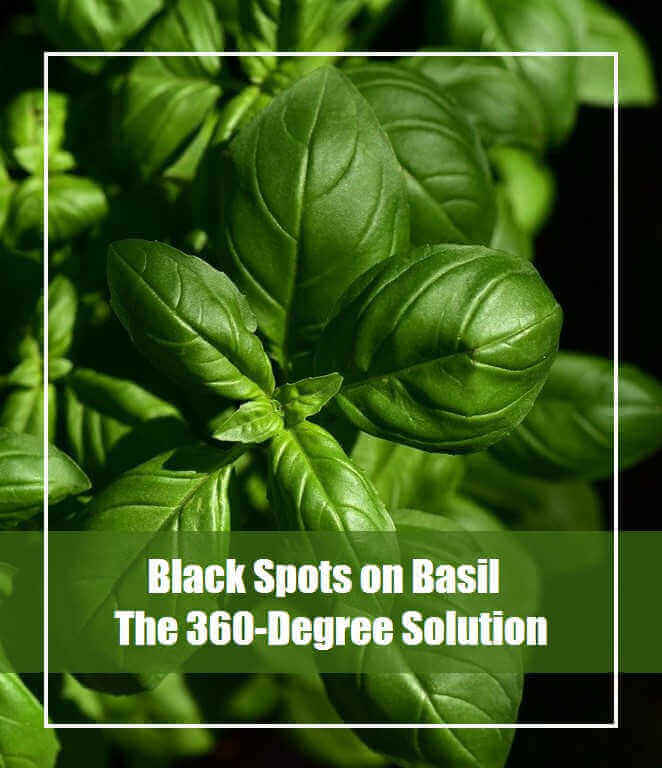Basil is a pretty common detox. However, this doesn’t mean that the plant is immune to diseases.
Basil plants can get into various types of problems. And black spots on basil is one of those. Now if you’re producing basil for personal use then this might not be a huge problem. But if you’re planning on sending basil leaves to the market, then it’s time to be concerned.
A normal solution of black spots on the basil plant is removing the leaves. But this has more to it.
Here’s the thing-
You have to treat the plant pretty fast. Because the more you wait, the more is the chance of spreading the disease.
Now, let’s stop wasting any more time, and jump right into the details-
Why Do Basil Leaves Turn Black?
In the gardening forums, you’ll see a pretty common question from time to time. Gardeners ask up, why does my basil have black spots on it?
Well, we’re here to answer that exact question. Dark spots on basil leaves can happen because of three reasons. These are-
– Bacterial infection
– Fungal infection
– Bugs
Now, let’s explore the reasons for a deeper look.
Bacterial Infection
Pseudomonas cichorii is the name of the culprit in this scenario. This bacteria at first attacks the soil and then spreads to the leaves. Some even consider this disease as a seed-borne one. That’s why don’t get surprised if you get black spots on basil seedlings.
So, how can we differentiate the bacterial black spot from the other types?
Well, the bacterial spot will be dark and water-soaked. More specifically, the spot will feel a bit waxy. And that’s the best identification of this culprit.
Fungal Infection
Here’s the two-step checklist for detecting fungi infection-
– Basil has black spots on it
– The spots are dry
Moreover, in fungal infections, you’ll see active spots beneath the leaf. Fungi love slight darkness and moisture. But keep in mind that this moisture-loving culprit creates tiny black spots on basil leaves.
We’re focusing on the dry spot part because many people think fungal infections cannot be dry.
Bugs
There’s a debate about what type of bug exactly creates dark spots on basil leaves but there’s a shortlist. Thrips, vine weevils, cabbage worms and lastly leaf miners.
There’s a pattern for this type of invasion. You’ll see your basil leaves turning black one by one. At first, you’ll see black leaves on one plant. And then you’ll see other basil plants getting infected. And at some point, you’ll see other plants in your garden showing up black leaves.
The lucky gardeners can sometimes catch these culprits red-handed. Some of those lucky gardeners get confused and type in, “black things on my basil plant”. It’s easy to get confused actually. Because these bugs can be really small and it’s hard to differentiate these from other infections.
But just as we said earlier, look if other plants are getting affected. That’s the most important determinant of bug invasions.
How to Treat Black Spots on Basil Leaves?

Till now we’ve explored some types of basil plant diseases. Although these show the same type of symptoms, these have different backgrounds.
So, it’s natural that we’ll have different solutions. And here we’ve covered all of those. So, let’s get going with the black spots on basil treatment –
Solution for Bacterial Infection
The sad news is there’s no proper solution for bacterial infections. All you can do is change the environment.
Start by changing the soil. Most probably the soil played a part in the infection. So, changing it might help the plant.
Next, try to determine the soil nutrient level. If you find anything wrong, try to balance it properly. And try to use natural fertilizers for some time. At this point, you need that plant to survive. So, there’s no need for using fertilizers to increase its growth.
Lastly, try to bring more fresh airflow to it.
However, there’s no guarantee of success even after these efforts. Your plant might give in to the bacteria completely.
Solution for Fungal Infection
If you’re asking around, “how to get rid of black spots on basil leaves?”, then this is the place to be. This is the exact method where we will get rid of those black spots.
By now you must have known how to detect fungal infections. But before jumping into the treatment method, you should gather up some items. To be more specific you’ll need to make an anti-fungal solution.
No worries. It’s super easy to make the solution. All you’ll need is some baking soda.
So, how to make it? Well, mix one teaspoon of baking soda with 4 cups of water. And you’ll have your solution ready.
Now that you’ve got everything ready, let’s go straight to the treatment steps-
– At first, take a pair of sterilized scissors.
– Next cut off the infected leaves.
– Pull up the plant and remove old soil from its roots.
– Place it in some new place.
– Spray the antifungal solution over the plant.
– Let it stabilize.
Hopefully, your plant will get back to normal. In severe condition apply the fungicide. Here is the recommended fungicide for your basil-
Solution for Bug Invasion
Bugs can be a real pain in the back. Some bugs are easy to repel. While some are super stubborn and tough.
Moreover, each bug has a bit different type of remedy. However, there is a general remedy for most of the bugs. That is neem.
But if your plants have leaf miners then you’ll have to go the extra mile. So, here we have solutions in two parts. One for regular bugs and the other for leaf miners.
Now, for any average bug, using neem oil or insecticidal soap is sufficient. You can make it at home by extracting neem oil from neem seeds. If you don’t want to take that hassle then, spray neem oil or regular insecticidal soap.
Now, for the leaf miners, the hard part is determining the time. If the time isn’t perfect, then your insecticide won’t even reach the bugs. So, how to select the time?
Take some of the leaves into a Ziplock bag on the very first time you spot leaf miners. Next, lock up the bag and wait.At one point, you’ll see small black flies inside the bag. Apply insecticide on your plant at that time.
Although there’s a super low chance that leaf miners will create black spots on your leaves, still, let’s not throw it out of consideration.
Here is the recommended neem oil or insecticidal soap for your basil-
How to Prevent Black Spots on Basil?
Prevention is considered as the best solution. So, how to prevent these issues?
Well, firstly, taking proper care of the garden can reduce the probability of any kind of plant infection. So, make sure that you pay regular attention to it.
Little practices can save a lot of time. For example, sterilizing your knives and scissors can save your plant from bacterial infections.
Both the bacterial and fungal infection happens in warm, humid weather. So, little practices in the watering can help prevent infections. For instance, you can try watering the plants in the morning. This way, the weather will have
more time to wick the moisture from the plant.
Moreover, try to avoid watering from above. In this way, your leaves won’t have to drown in moisture.
Lastly, make sure that your basil plants have enough space between them. Because a lack of proper air circulation builds up humidity.
How to Tell if Basil is Bad? – Eating Perspective
Our digestive system is pretty strong actually. That’s why sometimes we end up being okay even after eating unhealthy stuff.
Here the actual question is, to what point can we eat basil? To what extent is it safe?
To be specific there can be two common types of issues in the case of basil. Firstly, the plant might have black spots and secondly, the leaves might have holes in it. Now let’s look at each of the issues from an eating perspective.
Can You Eat Black Basil Leaves?
Technically yes. Many will suggest you cut off the black spot and then eat the rest. But we have a different opinion.
You know how to figure out the infection source from the black spot. So, if it’s a bacterial infection, then you can go with the cutting and eating part.
However, if the infection is fungal then cutting won’t do you any good. Fungus tends to have very deep roots. So, if there’s even a small spot on the leaf, then you can consider that the whole leaf has roots in it.
Ultimately, if you don’t want to eat the fungus then you have to discard the whole leaf.
So, are black spots on basil leaves safe to eat? The answer is, it depends. We’d suggest you avoid eating the infected leaves.
Is It Safe to Eat Basil With Holes?
You can eat the basil. Just cut off the holed leaves before eating. It’s best that something infected doesn’t go inside of you. Who knows, maybe you can get food poisoning from that. Not everyone has the same stomach.
Bottom Line
Black spots on basil are avoidable and easy to cure. However, being indifferent can cost you heavy in the future. So, if your plants have black spots, then quickly figure out the source and take action. Happy gardening.


